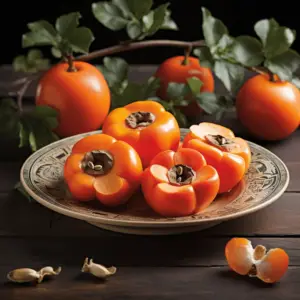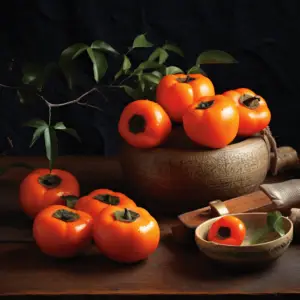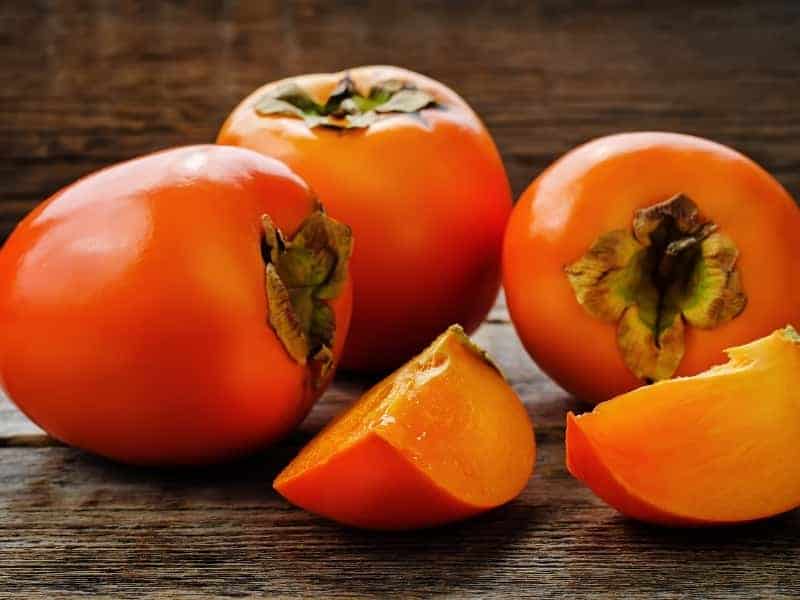Eat Persimmons one thing that apples, pears, and persimmons all have in common is that they’re all fall fruits. But sadly, the humble persimmon doesn’t seem to get the attention it deserves.
To those who are new to persimmons, chances are you’ll find yourself staring at it unsure how to eat it the first time you get one in your hand. Do you chomp right into it like an apple or should you peel it like a lemon? Or is it a good idea to eat the skin along with the rest of the persimmon?
Here’s all you need to know about persimmons, including how to eat them, cook and store them.
Can You Eat Persimmon Skin?

Well, yes, you can eat persimmon skin. Not only is it safe to do so, but you’ll also find it quite easy as the peel isn’t all that tough. A ripe persimmon normally has a sweet, honey-like flavor, similar to that of an apricot. These fruits are associated with as much fiber as an apple in some cases.
That said, though, not all persimmons are created equal. Contrary to a sweet, ripe persimmon, unripe astringent persimmon will easily make you recoil at its bitter flavor.
Some persimmons are spherical while others have the shape of an acorn or pumpkin. In terms of size, Persimmons can range anywhere from the size of a half-dollar to a small grapefruit.
Put simply, persimmon is a fruit that’s obtained from certain trees in the genus Diospyros. Like tomatoes, a persimmon is technically a berry but rarely considered one.
These fruits are picked in late fall and sometimes stay on the tree into winter. Subject to the strain, the color may vary from yellow to dark red-orange.
Check out the differences between the two most common types of persimmons- Hachiyas and Fuyus- before heading to your local farmers’ market or supermarket.
Types of Persimmons
Persimmons are loaded with fiber, antioxidants, vitamins, and minerals. Occasionally, you can find them in many firm markets and supermarkets. They are sweet and delicious on their own as well as in cooked dishes and baked items.
When buying a persimmon to eat, it’s important to know if it is astringent or non-astringent. Persimmons varieties that are commercially available in Florida and California may be either. However, the most common among these are the Fuyu and Hachiya persimmons.
While non-astringent persimmons may be eaten while hard or after they soften, astringent persimmons should only be consumed after they have fully ripped, turning soft and deep in color.
Hachiyas: Also known as astringent or bitter persimmons, should not be eaten until fully ripe. Until they have attained peak ripeness, Hachiyas will give off a virtually inedible chalky taste.
To steer clear of the unpleasant taste, check that the Hachiyas have ripened, soft like they’re about to burst. This will help to dissipate the tannins, and you’ll have a sweet smooth persimmon.
This type of persimmon naturally has a long shape that tapers off the bottom, almost like an acorn.
Fuyus: Also known as sweet or non-astringent persimmons are relatively sweet with firm flesh. They have a squat shape similar to that of tomato-esque with a flat bottom. Unlike astringent persimmons, you can eat Fuyus while they’re still quite firm like an apple. You can use them raw or enjoy them in sweet and savory dishes.
How to Eat Persimmons
Now that you already know whether it’s a Fuyu or Hachiya, here are a few tips for how to eat a persimmon.
A persimmon peel is edible and should be thoroughly washed before consumption. Wash the persimmon under running water and dry the outside of the peel with a clean towel. Use a knife to cut off the leaf-like flower and stem.
Note that Fuyu persimmons are best when they’re firm. So prepare them like you would with raw apples. Cut the fruit in half from the stem to the tail, splitting the core into two halves. Then cut each half of the persimmon into thin wedges or rounds.
Hachiya persimmons, on the other hand, are best when they’re mushy. You may want to prepare them like you would with raw avocado. Simply cut the fruit in half and scoop out the scoffs flesh from both halves. Alternatively, you can cut off the top, like a soft-boiled egg, and enjoy the gelatinous flesh from the rest of the bowl.
Buying Persimmons
Persimmons are commercially available at farmers’ markets and supermarkets, from late summer all the way through December. When buying persimmons, don’t go for bruised, ruptured, or lopsided fruits, and keep in mind the type of persimmon you’re choosing when checking ripeness.
Storing Persimmons

Fuyus can be stored in the fridge to prolong their shelf life, given that they should already be ripe the day you bring them home. That way, they can remain fresh even for weeks.
On the other hand, Hachiyas should be kept at room temperature so they can soften and sweeten up. If you want to speed the ripening process, consider storing them near other fruits that give off ethylene gas such as bananas.
After they have achieved the peaked ripeness, you can either eat them immediately or transfer them to the fridge and store them for up to several weeks.
Occasionally, baking recipes will call for persimmon puree, which is simply the ripe persimmon flesh that has been pureed in a blender or food processor.
You can also freeze cubed or slice persimmon flesh by first flash-freezing it on a baking sheet, and then transferring it to an air-tight container.
You might want to keep some persimmon puree ready for your fall baking projects by storing it in an air-tight container and freezing it for up to half a year.


